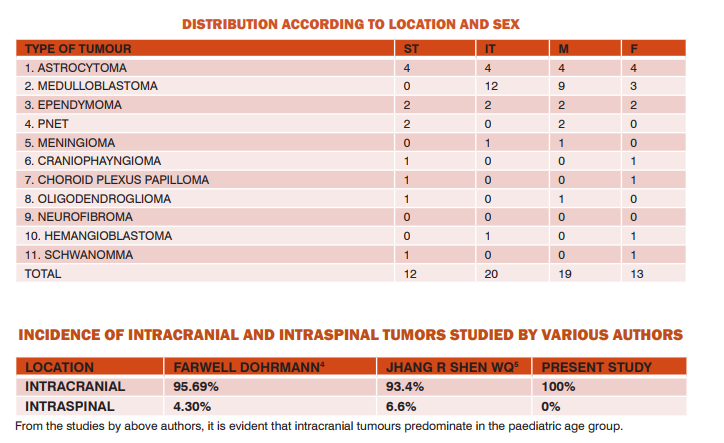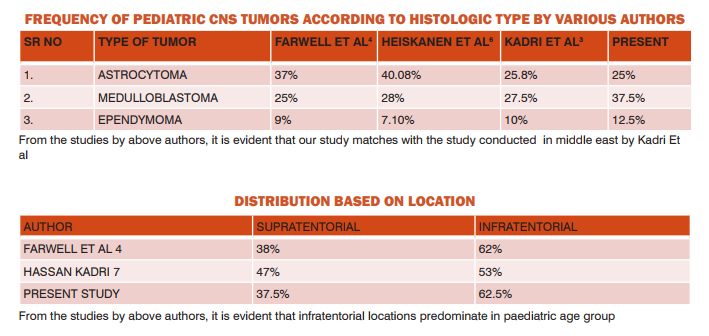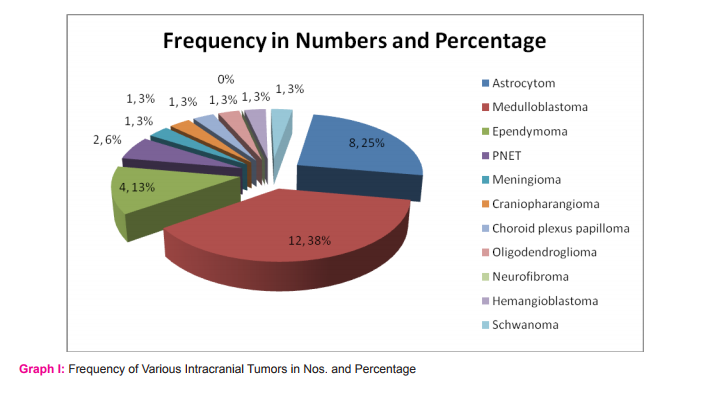IJCRR - 8(8), April, 2016
Pages: 32-36
Date of Publication: 20-Apr-2016
Print Article
Download XML Download PDF
STUDY OF PAEDIATRIC CNS TUMORS IN TERTIARY CARE CENTER
Author: Grishma P. Jobanputra
Category: Healthcare
Abstract:Objective: To elaborate pattern and frequency of CNS Tumors in a tertiary care center. Primary Neoplasm of the Central Nervous system are the most common solid tumors of childhood, making up 20% of all paediatric oncologic conditions,1,7 surpassed only by leukemia and lymphoma in frequency2 . They have tendency to occur along the central neural axis and posterior fossa and CNS metastasis from extra-cerebral tumors are uncommon in childhood. Material Andmethod: In the present study, A two year retrospective review of CNS tumors in paediatric age group (< 12 years) was conducted in tertiary care center. 32 cases of paediatric CNS tumors were studied for their incidence in relation to age, sex, location and histopathological features were evaluated with clinical and radiological correlation. Conclusion: All the cases were found intracranial. Overall there is a male preponderance in the paediatric CNS tumors and the incidence is quite similar to study conducted in Middle East region but somehow different than those reported by authors from the Western and Far Eastern countries.
Keywords: Intracranial, Infratentorial, Medulloblastoma
Full Text:
INTRODUCTION
Primary Neoplasm of the Central Nervous system (CNS) are the most common solid tumors of childhood, making up 20% of all paediatric oncologic conditions1,7 and are surpassed only by leukemia and lymphoma in frequency2 . They have included many histological subtypes, which vary in their site of origin and degree of malignancy. Seventy percent of childhood CNS tumours arise in the posterior fossa; a comparable number of tumours in adults arise within the cerebral hemispheres above the tentorium.7 Thus overall, infratentorial tumors occurs more in frequency then supratentorial tumors. Supratentorial tumors are more common in <2yrs of age while infratentorial tumors are more common in 4-10yrs and equally common after 10yrsof age.
CLINICAL PRESENTATION:
Clinical symptoms depend upon age, sex, location and type of tumor and grade Symptoms may include
• Infants-Increasing head circumference, lethargy, nausea and vomiting.
• Children-Also may have headaches, ↓visual acuity, seizures, cranial nerve palsies, endocrine dysfunction, Increased intracranial pressure, hormonal changes (pituitary adenoma). Classification of tumours is one of the arts of pathology, drawing on emerging molecular methods and the traditional recognition of histologic and biologic patterns. While pathologists have developed classification schemes that distinguish between benign and malignant lesions on histologic grounds, the clinical course of disease is also influenced by relatively unique features of brain tumours.
CLASSIFICATION7:
• Posterior fossa
• Supratentorial
♦ Intraparenchymal
♦ Sellar/Suprasellar
♦ Extra-axial Most common types of Primary Brain Tumours • Astrocytomas - Grades I-IV • Medulloblastomas
• Ependymoma
• Oligodendroglioma
• Meningioma Pituitary adenomas
• Choroid Plexus Papilloma
HOW THEY VARY FROM ADULT
• Unlike tumors of adults, childhood brain tumors have tendency to occur along the central neural axis and posterior fossa.9,11. In Adults: 70% of tumors are supratentorial
• Meningioma
• Pituitary adenoma
• High grade astrocytoma
♦ Anaplastic astrocytoma (grade III)
♦ Glioblastoma multiforme (grade IV astrocytoma) In Pediatric: 70% are in posterior fossa
• Medulloblastoma
• Pilocytic astrocytoma (cerebellar astrocytoma)
• CNS metastasis from extra-cerebral tumors are uncommon in childhood.11
AIMS AND OBJECTIVES
The study was undertaken with the following aims and objectives:
• To elaborate the pattern and frequency of CNS Tumors in a tertiary care center.
• To study the pathology of CNS tumors in relation to age, sex, location and incidence.
• To study the relative incidence of various CNS tumors among different paediatric age groups.
• To compare the obtained results with previous studies.
MATERIAL AND METHOD A Study of two year review of CNS tumours in paediatric age group (<12 years) was conducted in one of the teaching tertiary care hospital, Ahmedabad. Study includes all tumours occurs in CNS in <12 years of age group. Histopathological features were evaluated with clinical and radiological correlation. The clinical details are obtained from original case record. The gross examination of each available specimen includes its size, shape, weight, consistency and appearance of cut surface especially pertaining to areas of Haemorrhage, necrosis and cystic spaces. Total 32 cases were found to have primary CNS tumours. All the specimens were preserved in 10% formalin.
In histopathological study, no. of sections were taken from different sites according to the size of the specimen while in case of small biopsy whole specimen was given. Sections were processed in automated tissue processor and embedded in paraffin blocks. All the sections were studied by routine paraffin sectioning and Haematoxylin and eosin stain. Selected cases may require special stain. The tumours classified according to (WHO) World Health Organisation’s histological typing of CNS Tumours. Data acquired from examination of each specimen was processed in systemic manner. The collected data were analysed statistically and results obtained are compared with existing studies in the literature.
RESULTS
During the period of January 2013 to December 2015; a total of 12587 specimens were received for histopathological examination. Out of which 164 specimens were of CNS tumors, among which 32 cases were of <12 years, in paediatric age group. All the cases were intracranial. Out of 32 cases 20 were infratentorial (62%) and 12 were supratentorial (38%). Sex wise distribution show 19 (59%) were males and 13(41%) were females.(Table II) The frequency of various tumors show that Medulloblastomas were the single most frequent tumor (37.5%), followed by Astrocytoma (25%) and Ependymoma (12.5%) and rest were Meningioma, Choroid plexus papilloma, Craniopharyngioma.(Table I) In our study male preponderance is present with M: F ratio of 1.46: 1. The most common clinical presentation was hydrocephalus, seizures and nausea vomiting in infant and seizures, increased intracranial pressure and headache in children.
DISCUSSION
This present study was conducted over period of two year from January 2013 to December 2015 in one of the tertiary care teaching hospital. Studies of 32 cases were done with respect of sex, location of tumor and with morphological type of tumor. The results obtained were compared with those of previous studies of well-known workers in this study and the significant difference and similarities in result are discussed below. This study show all the cases were intracranial as compare to other authors Farwellet al4 and Jhang R Shen WQ et al.5 (Table III) In this study Medulloblastoma were the single most frequent tumor followed by astrocytomas and ependymoma. It is evident that our study matches with the study conducted in Middle East by Kadari et al.3 (Table IV) In present study out of 32 cases 20 were infratentorial (62%) and 12 were supratentorial (38%) which is comparable with other authors Farwell et al4 and Hassan Kadri et al3 .(Table V) In our study male preponderance is present with M: F ratio of 1.46 : 1.
CONCLUSION
• 32 cases of paediatric CNS tumours were studied in present study for their histopathology and incidence in relation to age, sex, location and incidence.
• Almost all the cases were found intracranial.
• In decreasing order of frequency, the intracranial tumours are Medulloblastoma, Astrocytoma, Ependymoma, PNET, Meningioma, Craniopharyngioma, Choroid Plexus Papilloma.
• In our patient population, the incidence is quite similar to study conducted in Middle East region but somehow different than those reported by authors from the Western and Far Eastern countries. Whether these results are unique or reflect a regional difference in the disease distribution, remains to be determined
. • Overall there is a male preponderance in the paediatric CNS tumours.
• Overall paediatric tumours predominate in the infratentorial regions.
• All medulloblastomas were infratentorial.
ACKNOWLEDGEMENT
The author acknowledges the help received from Dr. Hansa Goswami, MD. PATH, Professor and Head, Department of Pathology for teaching me the scientific approach of the subject and its subtle aspects. I am also thankful to Dr.Urvi Parikh, MD. PATH, Assistant Professor Pathology Dept., B.J. Medical College, Ahmedabad for motivating me for doing the work meticulously and her kind co-operation. I would like to give my special thanks to all the technicians of Histopathology Section, Pathology Dept., B.J. Medical College, Ahmedabad for helping me while conducting the present study. Last but not least Author acknowledge the immense help received from the scholars whose articles are cited and included in references of this manuscript. The author is also grateful to authors / editors / publishers of all those articles, journals and books from where the literature for this article has been reviewed and discussed.
References:
1. Atlas of paediatric Oncology: D.Sinniah; giulio J. D’Angio; Jane Chatten; Mahboubi; Henrietta Rosenberg.
2. Young JR, Dohrmann GJ, Flannery Jt. Intracranial Neoplasm in infants.
3. Hassari Kadri, Alkhakam A. Mawla, Lina Murad Incidence of childhood brain tumours in Syria,(1993-2002).
4. Farwell Jr ; Dohrman GJ and Flannery Jt. Medulloblastoma in childhood; an epidemiologic study journal of neurosurgery.
5. Jacqueline R. Farwell, MD , George J. Dohrmann, MD, George J. Dohrmann, MD, PH.D and John T. Flannery , BS : Central Nervous System in children.
6. Heiskanen O:Intracranial tumours of children.
7. Rosai and Ackerman’s Surgical Pathology, 10th edition, Vol. 2
8. Robbins SL; Cartan RS ; and Kumar V. Robbin’s Pathological Basis of Disease. 8th edition.
9. Brain and other central nervous tumours- UK incidence statistics, Cancer Research UK.
10. Wilne S, Koller K,Collier J , et al; The diagnosis of brain tumours in children: a guideline to assist healthcare Arch Dis Child. 2010 Jul;95(7):534-9. Epub 2010 Apr 6. [abstract]
11. Childhood cancer incidence statistics, Cancer Research UK, Oct 2005.



|






 This work is licensed under a Creative Commons Attribution-NonCommercial 4.0 International License
This work is licensed under a Creative Commons Attribution-NonCommercial 4.0 International License